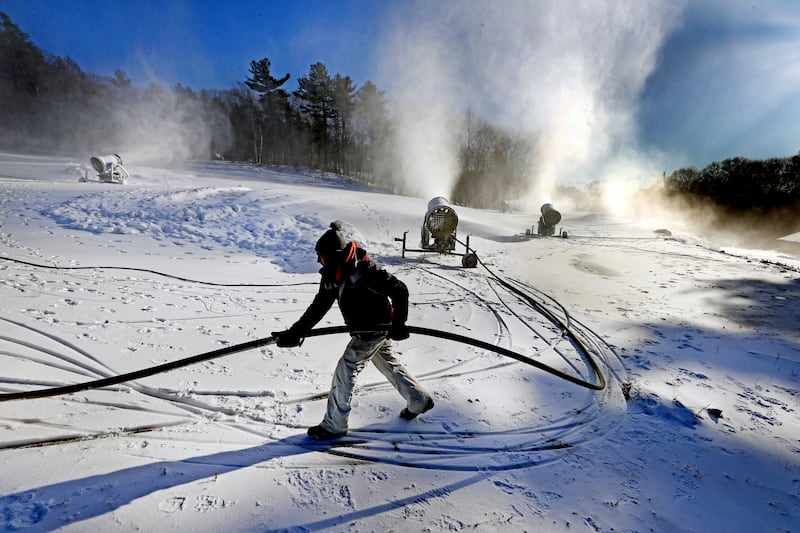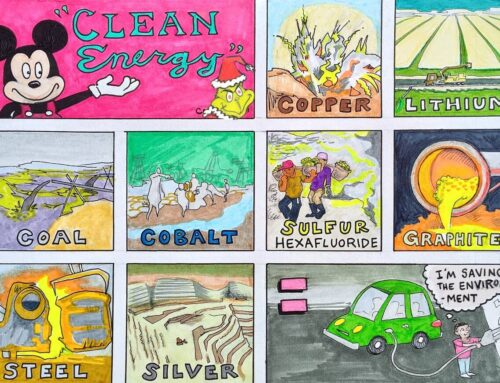How ski resorts brace for a snowless future
December 23, 2024
When Elizabeth Burakowski first visited Black Mountain in 2019, she found something familiar. The New Hampshire ski area, founded in the 1930s, evoked emotions she’d felt as a kid, and later as an adult, on the many mountainsides she’d shredded across the state. It stirred memories of going night skiing as a teenager, that first taste of running loose and wild in the world. Of building makeshift ramps. Falling. Rising. Falling again. Of hopping off a moving ski lift before it reached its terminus and falling in a splash of white powder.
Lately, those memories have started to feel further away. It’s her burden to bear as an avid skier who is also a leading local climate scientist. Her research, based out of the University of New Hampshire, explores how carbon emissions are changing winter. She can’t help noticing those changes when she tries to escape to the slopes. When she looks down from a lift and finds brown leaves. Dead grass where white snow once was. Rocks jutting up like bones. Leaping off the lift mid-ride like she used to. “Now,” Burakowski says, “you’d be breaking your leg.” Scheduled to return to Black Mountain in 2021, two years after that charmed, nostalgia-gilded visit, she couldn’t. The oldest ski area in the state — one of the oldest in the country — had run out of snow.
Then, in October 2023, the owner of Black Mountain announced the storied resort would close for good. His press release listed several factors, but the first two were “soaring energy costs” and “unpredictable weather.” Burakowski came across the announcement on Instagram and wasn’t surprised. She knows those challenges are afflicting ski areas all over the world — especially independent outfits like Black, as locals call it, that don’t have the same mitigation tools as competitors. Lagging snowfall, especially for several years in a row, can be a death blow.
It’s a trend that has begun swallowing resorts in Europe. In France, multiple longtime ski areas have called it quits. In Switzerland, one outfit had to order a snow delivery via helicopter. In Germany, spectators watched biathlon skiers zip by on a human-made ribbon of white while the rest of the hillside was green and brown. Resorts across the Alps couldn’t open during Christmas because rain fell instead of snow.
In North America, the Environmental Protection Agency reports that between 1972 and 2013, yearly snow cover declined by an average of two weeks per year. Between 1972 and 2020, the portion of the continent covered by snow decreased by about 1,870 miles annually — an area roughly the size of Delaware. From 1982 through 2021, per the EPA, average snowpack decreased at about 80 percent of the measured areas. A team of Colorado-based researchers found in 2017 that “virtually all locations are projected to see reductions in winter recreation season lengths, exceeding 50 percent by 2050 and 80 percent in 2090 for some downhill skiing locations.” And a 2024 study found that by 2100, 1 in 8 current ski areas could have no snow. “Climate change is an existential threat,” says Tonya Riley, a spokesperson for the National Ski Areas Association. “Our industry is proud to be a leader in advocacy, mitigation and resiliency, but we need buy-in from other industries and everyone who loves the outdoors.”
Back at Black Mountain, the closure didn’t come to fruition. Or, rather, it hasn’t. Not yet. A ski entrepreneur stepped in and offered to keep the lights on last season, with a promise to find a new buyer ahead of 2024-25. That proved difficult. Changing weather patterns aren’t the only threat facing Black Mountain. Labor shortages, corporate consolidation, stiff competition — all could spell doom. But the weather looms as an accelerant; as a force that could make any one of those more immediate problems worse, thus burning the whole thing down. For now, Black could show other ski areas, from the East Coast to the West, what’s possible. Or what’s not.
Lagging snowfall, especially for several years in a row, can be a death blow. “That adds up. And then that turns into a climate challenge.”
The future of Black Mountain in New Hampshire
Just about everyone I spoke with in New Hampshire talks about climate change as a matter of fact. That wasn’t always the case. “When I started here 10 years ago,” says Jessyca Keeler, president of Ski NH, “climate change was a little bit of a dirty word.” But now, the consequences are simply undeniable. “You have shorter winters. I mean — we are seeing it,” she says. “It’s documented.”
That’s thanks, in part, to Burakowski, the climate scientist whose research has quantified the impact of greenhouse gases on New Hampshire winters, and who has lived and skied in the state since the 1980s. “I’ve witnessed these changes,” she says. “And the very same mountains that grew my love for winter and outdoor sports are also the same ones that are seeing the symptoms of climate change.”

Her research shows that since 1970, winter has become, on average, five degrees warmer. That means a much higher likelihood of winter rains and temperatures above freezing. It means a much less stable snowpack; in fact, her research suggests central New Hampshire’s average snowpack has decreased by 60 percent over the same time span. “This broad symptom of winter warming is manifesting in our snow, in our ice, and in these midwinter warm spells,” she says.
The manufacture of artificial snow, a stop-gap solution for many resorts, including Black Mountain, poses its own environmental and economic problems. Snowmaking can be energy-intensive, leaving behind a large carbon footprint. But without it, many resorts can’t reliably stay open, which is why many resorts have invested in more efficient, less energy-draining systems. “I think ski resorts are doing their best to be part of that solution,” Burakowski says, “by reducing their own carbon emissions through renewable energy, through energy efficiency.” Doing so saves money on energy bills while also granting some control over day-to-day operations when the weather doesn’t cooperate.
On this point, Black Mountain’s new owner, Erik Mogensen, has been clear: Black Mountain needs to make a lot more snow to be viable. It’s especially important since Black is a south-facing slope, meaning it gets direct sunlight for most of the day. That’s why he enlisted Doug Fichera, son of former Black Mountain owner John Fichera, to be the mountain’s director of operations. Doug has spent his whole life making snow. “Snowmaking is my art form; it’s how I release my energy. It is my one true passion in life, and I enjoy it more than anything,” he told Ski Area Management magazine some 10 years ago. “However, it isn’t just the operation of it. It’s the process, the engineering and the constant pursuit of higher efficiency due to sky-high energy costs.” That will be key if current warming trends continue.
To understand what Black Mountain might look like in 40 or 50 years, Mogensen points to ski areas in Maryland or Pennsylvania, where the elevation is lower. “They essentially no longer depend on natural snowfall,” he says. “There’s just no operating those places without a substantial snowmaking system.” But investing in those systems is complicated for an independent ski area like Black Mountain, where they can end up costing more than the land is worth. “Resorts have gotten really good at snowmaking,” Burakowski says. It’s impressive, and it’s hopeful. But she still worries that eventually, it won’t be enough for many of them.
She sometimes thinks about a paper she worked on that analyzed historical trends in New Hampshire winters. She found that since 2008 only once, in 2015, did northern New Hampshire experience a winter colder than the 20th-century average. She often wonders whether that will be the last time it happens. “That keeps me up at night,” she admits. And she isn’t alone.
“(This) is a global problem for skiing. It is already affecting ski resorts worldwide. Every ski area in the world is going to eventually be affected.”
Ski resorts adapt to less snow
This past October, in southern France, the Alpe du Grand Serre ski resort — at 7,165 feet, more than twice the height of Black Mountain — announced permanent closure due to warming temperatures. The resort joined a growing list of ski areas in the Alps — whether French, Swiss or German — that have shuttered for the same reason in recent years.
In the Western United States, meanwhile, the situation isn’t as dire. Many Western resorts have nevertheless used their borrowed time to prepare for what’s coming. Deer Valley, in Park City, has invested in low-energy snowmaking guns, along with a solar farm that will power it and its neighbor resort, Park City Mountain. “We are focused on reducing our net emissions,” Park City Mountain spokesperson Emily McDonald told me, “investing in renewable energy, … reducing waste to landfills and reducing our net operating footprint on the natural environment.” Alta, just outside Salt Lake City, conducts year-round environmental initiatives, including purchasing renewable energy credits to offset its carbon footprint and implementing a long-term plan that calls for water-conscious upgrades to its snowmaking system.
Those efforts can’t stop warming, but they can help ski resorts remain ethically consistent. And better snowmaking efficiency and offseason diversification can help offset lost snow for now.
The ski areas most vulnerable to climate change, explains University of Utah professor of atmospheric sciences Jim Steenburgh, are those at lower elevations. Places like Black Mountain. The West might have more natural insulation, but it’s not immune. “The West is experiencing the effects of climate change,” Steenburgh says. “We are already seeing, for example, a greater fraction of precipitation falling as rain instead of snow. We are also seeing snowpack declines.” These trends are most visible at lower elevations, but if warming trends continue, they will spread over time. “Climate change is a global problem for skiing. It is already affecting ski resorts worldwide. Every ski area in the world is going to eventually be affected.”

Adaptation can take many forms. At Black Mountain, it’s making more snow. In Colorado, it’s new, high-altitude glades and trails that capitalize on colder temperatures and terrain that can hold more snow for longer. In Europe, it’s closure. Or, in the case of one traditional Swiss ski town, the addition of goats as an alternative attraction when the slopes run brown. And in New Mexico, home of Taos Ski Valley, it can look like tackling the root of climate change more directly, like in Park City and at Alta — whether the impact will be felt or not. “We’re proud to have begun to electrify our fleet of vehicles, including deploying North America’s first all-electric snowcat for grooming,” Dawn Boulware, Taos Ski Valley’s vice president of social and environmental responsibility, told me. “Across the industry resorts and mountain towns are taking collective actions to ensure a viable future for skiing.”
Few places, if any, embody this “collective action” more than Black Mountain could in the years ahead.
In one traditional Swiss ski town, locals have incorporated goats as an alternative tourist attraction when the slopes run brown.
‘The soul of skiing’
Last October, a crowd gathered in a wooden lodge at Black Mountain. Beneath a line of whirring ceiling fans running down the spine of the room, the crowd sipped wine and chatted in clusters until Mogensen — thick brown hair, sleek black-and-silver glasses, blue flannel rolled up at the sleeves — strode to the front, microphone in hand. He stood before a screen displaying a purposely vague title: “Community meeting: The future of Black Mountain.” “Let’s get crackin’ here,” he said, and the chatter stopped right away.
He implored the crowd to move closer. “This lodge is standing-room-only right now,” he told them. “The parking lot is maxed out. So I think we can call this a powder day.” The crowd cheered. He introduced himself as the founder of the Colorado-based ski software company Entabeni Systems. He was flanked by three other men: Andy Shepard, an industry veteran known for rescuing struggling ski areas in the northeast; Doug Fichera, the young snowmaker with a scraggly beard; and, seated beside Mogensen, Doug’s father, John, the longtime owner of Black Mountain. They’d gathered for an announcement a year in the making.
The men highlighted industrywide issues beginning with corporate consolidation. In the early 2000s, the introduction of Icon and Epik passes revolutionized skiing, offering access to multiple ski areas with one pass. Initially seen as a great value, this has led to overcrowding and higher recreational skiing costs, as operators began acquiring mountains themselves, leading to a decline in family-owned ski areas. In Utah, for instance, Vail Resorts Inc., the largest ski area operator in the world, owns Park City, while its biggest competitor, Alterra Mountain Company, owns Solitude and Deer Valley, where adult one-day lift tickets in December cost an average $128 to $259, respectively.
The independent/community ski areas that do remain have therefore become the backbone of affordable skiing. “The industry needs to understand the role that these community ski areas play, and should be supporting these ski areas,” Shepard later told me. “But they haven’t been.” And that’s exactly what Mogensen is hoping to change. “What makes this place different, what makes this place unique, is what we’re gonna save and preserve,” he told the crowd. “That’s 100 percent what we’re after.” And to make that happen, he offered a road map.
To combat warming, he planned to double snowmaking capacity with Doug’s help. He also announced the acquisition of two brand-new snow groomers to help the snow they have on the ground last longer. “This is going to give us time to make more snow,” Mogensen added, “and do things better and shorten our labor.”
But the most important announcement Mogensen made truly stunned the crowd. He doesn’t plan to own Black Mountain for long. He’ll own it this year, turn around the lagging operations, then sell it again — to a very specific group. “We’re gonna get it to a really successful place. We’re gonna make it the soul of skiing,” he said. “And then, it is my intention to form a co-op and invite everyone in this room to own a piece of Black Mountain.” The crowd erupted. They’d all have a chance to own part of a treasured local institution. A chance to determine its future against the headwinds of consolidation and competition and labor shortages. Even climate change.
‘Turning around Black Mountain’
A few weeks later, when I chatted with Mogensen over the phone, he still sounded excited — but also nervous. “There’s a lot to unravel,” he admitted. The questions that demand immediate attention are less existential than climate change. They’re practical. “When it comes to the future of a single ski resort,” says Steenburgh, climate change and unpredictable weather patterns are “a threat multiplier.” An accelerant. “Vail and Alterra and large operators have access to capital,” Mogensen says, meaning they can weather those expenses while they develop new solutions to the problems. Black Mountain doesn’t have such luxury. “You have a couple bad seasons in there,” he adds, “you basically never get ahead enough.” That means eventual closure. And that’s why, despite promises of preservation, Mogensen knows Black Mountain needs to change.
When I visited in late October, weeks before the first patrons arrived, the slopes were still orange and red with fall foliage. They still lacked snow. But the mountain wasn’t perfectly still, either. Painters applied a new coat to the old lodge. Drill bits howled from lifts undergoing maintenance. And a pair of black Entabeni trailers rested in the parking lot, unused for now. When Shepard, Mogensen’s partner in turning around Black Mountain, looks at this landscape, he sees nothing less than something revolutionary: “A path to sustainability,” he told me, “for independent ski areas across North America.” Mogensen, meanwhile, sees a path that will require balancing ideas old and new. “Preservation doesn’t mean keeping it the same,” he explained. “If you don’t change, then the word preservation just goes away because there’s nothing there.”
One thing stands out for Burakowski, the climate scientist, from her visit in 2019: Enthusiasm. She could see it in so many of the regular visitors. She could feel it herself. “It’s this place to gather, a place for community,” she says. “I think that’s worth saving.” Mogensen is betting big that the surrounding community will think that, too. And in that sense, what’s happening at Black is about more than the future of this mountain, or even the ski industry. It’s about trying to preserve something that can’t be appraised by dollars alone.
The real question at Black Mountain isn’t, will things change? That answer is, and always will be, yes. It’s whether some things — the most important things — can stay the same.
This story appears in the January/February 2025 issue of Deseret Magazine. Learn more about how to subscribe.
Search
RECENT PRESS RELEASES
Related Post





View Comments